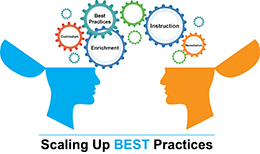BEST Practice #4:
Scaling Up BEST Practices

Scaling Up BEST Practices
The term "BEST Practice" in education is used to describe educational practices that have been proven to work and have positive student results.
Sharing best practices is a way for schools to improve student achievement. Working together gives educators opportunities to share what is already working in their schools. By using what is already working, schools:
• Improve the overall quality of services
• Avoid the duplication of effort or "reinventing the wheel"
• Increase productivity and efficiency
Schools meet regularly within their Socioeconomic Status (SES) Band to share best practices. An SES Band is a group of elementary, middle, high, and community schools across the state who service a population of students within a community in the same financial range. The financial range is based on the percentage of students on free and/or reduced lunch within the school. Schools are also encouraged to implement the best practices that have been shared within their SES Band.
The BEST Blueprint & AdvancED Accreditation Standards Correlation:
Standard 1 - Purpose and Direction:
Scaling up best practices ensures that each school engages in a systematic, inclusive, and comprehensive process to review, revise, and communicate a school purpose for student success. When schools meet within their SES bands, educators and administrators enhance and solidify shared values and beliefs about teaching and learning. These meetings support the development, implementation and continuous improvement of challenging, equitable programs and learning experiences for all students that include achievement of learning, thinking and life skills.
Standard 2 - Governance and Leadership:
By scaling up best practices, leadership and staff can identify and implement what works within similar cohorts. This level of sharing demonstrates the district’s commitment to student success and improved professional practices.
Standard 3 - Teaching and Assessing for Learning:
When teachers communicate with others within their SES bands, they are able to share and receive information and resources for improving instructional practices. These efforts often serve as the impetus for systematic adjustments to ensure a comprehensive approach to including or scaling up best practices.
Standard 4 - Resources and Support Systems:
In order to scale up best practices, schools communicate with each other across SES bands, and within academic areas. By doing so, teachers, instructional coaches and educational leaders are able to determine what works and what does not. Through long range planning, individuals and teams are able to set goals, create activities, and identify resources necessary to enhance and improve student achievement.
Standard 5 - Using Results for Continuous Improvement:
The scaling up of best practices, relies on data about student learning, instruction, program evaluation and organizational conditions that support learning. When professional and support staff review and analyze what works and are able to share across cohorts, teachers, students and families are impacted individually and collectively. Ideas, strategies, curricula, resources and tools are shared and implemented strategically and systematically for verifiable improvements in student learning.

